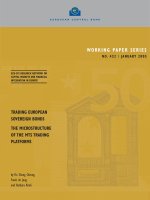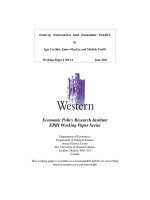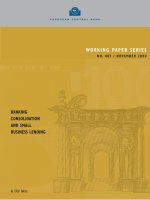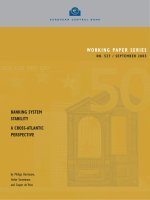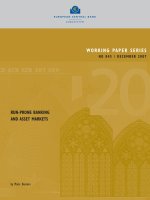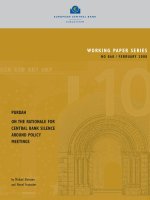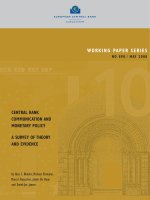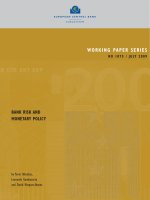WORKING PAPER SERIES 214 - DO INFLATION-LINKED BONDS CONTAIN INFORMATION ABOUT FUTURE INFLATION? pptx
Bạn đang xem bản rút gọn của tài liệu. Xem và tải ngay bản đầy đủ của tài liệu tại đây (543.62 KB, 31 trang )
ISSN 1518-3548
CGC 00.038.166/0001-05
Working Paper Series Brasília n. 214 Oct. 2010 p. 1-30
Working Paper Series
Edited by Research Department (Depep) – E-mail:
Editor: Benjamin Miranda Tabak – E-mail:
Editorial Assistant: Jane Sofia Moita – E-mail:
Head of Research Department: Adriana Soares Sales – E-mail:
The Banco Central do Brasil Working Papers are all evaluated in double blind referee process.
Reproduction is permitted only if source is stated as follows: Working Paper n. 214.
Authorized by Carlos Hamilton Vasconcelos Araújo, Deputy Governor for Economic Policy.
General Control of Publications
Banco Central do Brasil
Secre/Surel/Cogiv
SBS – Quadra 3 – Bloco B – Edifício-Sede – 1º andar
Caixa Postal 8.670
70074-900 Brasília – DF – Brazil
Phones: +55 (61) 3414-3710 and 3414-3565
Fax: +55 (61) 3414-3626
E-mail:
The views expressed in this work are those of the authors and do not necessarily reflect those of the Banco Central or
its members.
Although these Working Papers often represent preliminary work, citation of source is required when used or reproduced.
As opiniões expressas neste trabalho são exclusivamente do(s) autor(es) e não refletem, necessariamente, a visão do Banco
Central do Brasil.
Ainda que este artigo represente trabalho preliminar, é requerida a citação da fonte, mesmo quando reproduzido
parcialmente.
Consumer Complaints and Public Enquiries Center
Banco Central do Brasil
Secre/Surel/Diate
SBS – Quadra 3 – Bloco B – Edifício-Sede – 2º subsolo
70074-900 Brasília – DF – Brazil
Fax: +55 (61) 3414-2553
Internet:
Do inflation-linked bonds contain information
about future inflation?
Jos´e Valentim Machado Vicente
∗
Osmani Teixeira de Carvalho Guillen
†
The Working Papers should not be reported as representing the views
of the Banco Central do Brasil. The views expressed in the papers are
those of the author(s) and not necessarily reflect those of the Banco
Central do Brasil.
Abstract
There is a widespread belief that inflation-linked bonds are a di-
rect source of information about inflation expectations. In this paper
we address this issue by analyzing the relationship between break-
even inflation (the difference between nominal and real yields) and
future inflation. The dataset is extracted from Brazilian Treasury
bonds covering the period from April 2005 to July 2010. We find that
break-even inflation is an unbiased forecast only of the 3-month and
6-month ahead inflation. For medium horizons (12 and 18 months)
break-even inflation has weak explanatory power of future inflation.
Over long horizons (24 and 30 months), we report a significant, but
counterintuitive, negative relationship between the break-even and re-
alized inflations.
Keywords: inflation-linked bonds; real and nominal yields; term pre-
mia; break-even inflation
JEL Code: E31, E43, G12.
∗
Central Bank of Brazil. E-mail:
†
Central Bank of Brazil. E-mail:
3
1 Introduction
Market participants and policymakers interpret break-even inflation (the
spread between nominal and real yields) as the main indicator of expected
inflation. According to the Federal Reserve chairman, inflation-linked bonds
appear to be the most important source of future inflation expectations
(Bernanke, 2004). However, it is well known that the break-even inflation
rate (BEIR) can be decomposed as an inflation expectation plus a risk pre-
mium term. This leads to the following questions: Does the BEIR efficiently
predict future inflation? In other words, is the inflation risk premium neg-
ligible? A more general formulation of these issues can be stated as: Do
inflation-linked bonds contain information about future prices? In this pa-
per we shed light on these questions through a model free procedure using
data on Brazilian Treasury yields.
Our analysis is based on a series of regressions between the realized in-
flation (dependent variable) and the BEIR (independent variable) for the
horizons of 3, 6, 12, 18, 24 and 30 months. The significance of the param-
eters and R
2
provide a way to test the predictive ability and explanatory
power of the BEIR. To avoid specification problems such as autocorrelations
and endogeneity, we run these regressions using different approaches. First,
we consider an OLS procedure. Next, we employ instrumental variables, esti-
mating the model by TSLS and GMM techniques, with the covariance matrix
computed according to Newey and West (1987)
1
. The use of instrumental
variables aims to keep consistency when the regressor is correlated with the
error term, while the Newey-West method overcomes autocorrelation in the
residuals.
Many other studies have investigated the inflation risk premium and con-
sequently the relationship between break-even and realized inflations using
real and nominal interest rates. Among others we can cite D’Amico et al.
(2008), H¨ordahl (2008), Garcia and Werner (2010), Joyce et al. (2010),
and Grishchenko and Huang (2010). The first four papers work in an affine
arbitrage-free framework. D’Amico et al. (2008) show that although the U.S.
inflation-linked bond yields contain a liquidity premium and time-varying in-
flation risk premium, the Treasury Inflation-Protected Security (TIPS) rates
are a useful proxy for inflation expectations. Garcia and Werner (2010) ap-
ply a model similar to that used by D’Amico et al. (2008) in the euro area.
They find that the term structure of inflation risk premia is upward slop-
ing and varies from 7 to 25 basis points. H¨ordahl (2008) uses a structural
1
TSLS and GMM stand for Two-Step Least Squares and Generalized Method of Mo-
ments, respectively.
4
macroeconomic model to estimate inflation risk premia in the United States
and the euro area. He shows that inflation risk premia have an increasing
pattern with respect to maturity for the euro area and a flatter one for the
United States. Joyce et al. (2010) estimate a joint model of UK nominal
and real term structures. They find that the Bank of England’s indepen-
dence to set interest rates in May 1997 decreased the inflation risk premium
and the inflation expectation embodied in the term structure. The article of
Grishchenko and Huang (2010) computes the inflation risk premium as the
difference between the TIPS break-even inflation and an estimation of future
inflation. They show that the inflation risk premium is time-varying with
negative values from 2000 to 2004 and positive from 2004 to 2008.
However, none of the above studies use the methodology proposed in
this work. Our procedure to assess the information content in the BEIR
has previously been applied in other contexts. For example, Campbell and
Shiller (1991) test whether the slope of the term structure predicts changes
in interest rates. To this end, they run regressions of future yields on forward
yields. Christensen and Prabhala (1998) regress the realized volatility on the
implied volatility of S&P 500 to evaluate the relationship between these two
volatilities. Our strategy is close in spirit to Campbell and Shiller (1989)
and Christensen and Prabhala (1998), except we replace yields and volatility
by inflation. That is an innovation of this paper: a model free approach to
measure the explanatory power of the BEIR. To the best of our knowledge,
there is no study using this procedure to addresses this question.
Some countries have issued real return government securities. For ex-
ample, the United Kingdom has issued index-linked bonds since 1981. On
the other hand, the United States made its first issue in 1997, so the trad-
ing history is more recent. Although we could carry out this study based
on data from these countries, we opt to use a Brazilian database for two
reasons. First, Brazil is one of the most important emerging economies. To-
gether with Russia, India and China, Brazil forms the so-called BRICs, a
group of the most promising emerging markets. However, there are no stud-
ies about BEIR applied to an important emerging country. Second, unlike
other markets, the indexation lag of Brazilian real bonds is very small (only
a half month). Moreover, Brazilian real bonds do not have protection against
deflation
2
.
Our main findings can be summarized as follows. First, the BEIR is an
unbiased estimate only of the 3-month and 6-month ahead inflation. Second,
for the horizons of 12 and 18 months, the BEIR has weak explanatory power
2
The TIPS indexation lag is three months. Grishchenko and Huang (2010) point out
that ignoring the indexation lag results in an underestimate of the inflation risk premium.
5
for future inflation. On the other hand, the 24-month and 30-month break-
even inflations explain future inflation. However, for these two long horizons,
we obtain a surprising result: the relationship between the break-even and
realized inflations is negative. Of course these findings are not a puzzle. They
can be easily explained by a time-varying inflation risk premium, which is
not captured by our linear model. In other words, this suggests that the
expectations hypothesis fails for medium and long-term bonds. Finally, our
results are robust to a number of alternative econometric methods to estimate
the model.
The remainder of the paper is organized as follows. Section 2 presents
the data and stylized facts, while Section 3 discusses the methodology used
in this work. Section 4 presents the results and Section 5 concludes.
2 Model
Let y
n
t
(τ) and y
r
t
(τ) be the continuously compounded yields for nominal and
real yields at t with time to maturity τ. The BEIR is defined as:
i
t
(τ) = y
n
t
(τ) − y
r
t
(τ),
where i
t
(τ) is the BEIR for period t and horizon τ .
Denote by h
t
(1) the continuously compounded annual rate of change be-
tween two observations of a price index (from t to t + 1). Then, the accumu-
lated inflation rate between t and t + τ is given by
h
t
(τ) =
1
τ
t+τ −1
j=t
h
j
(1).
The information content of the BEIR can be assessed by estimating a
regression of the form
3
h
t
(τ) = c
1
i
t
(τ) + c
2
+
t
. (1)
Using Eq. (1), we can test if the BEIR contains some information about
future inflation. If c
1
is nonzero, the answer to this question is positive.
Moreover, we can verify if the BEIR is an unbiased forecast of realized infla-
tion. In this case, we should find that c
1
= 1 and c
2
= 0.
The BEIR can be decomposed as the sum of the expected inflation rate
plus a risk premium (see Grishchenko and Huang, 2010):
i
t
(τ) = E
t
(h
t
(τ)) + IRP
t
(τ), (2)
3
In fact, we should write c
τ
1
and c
τ
2
. However, we omit the superscript τ for brevity.
6
where E
t
(·) denotes the mathematical expectation conditional on informa-
tion available at time t. The expectation hypothesis states that the term
premium is constant over time but possibly maturity-dependent, that is,
IRP
t
(τ) does not depend on t. Under this hypothesis and using a further
assumption of rational expectations, the econometric specification of (2) is
given by (1). Therefore, Eq. (1) can also be used to test a BEIR version of
the expectation hypothesis.
3 Data and stylized facts
Our sample consists of a monthly series of real and nominal yields from
April 2005 to July 2010. This dataset is provided by the National Asso-
ciation of Financial Market Institutions (ANDIMA)
4
. The term structure
of nominal rates is extracted from plain vanilla (NTN-F) and zero-coupon
(LTN) Brazilian Treasury bonds using the Svensson interpolation model (see
Svensson, 1994). The face value of the NTN-F is R$ 1,000.00 (one thousand
Brazilian Reals) and it pays a bi-annual interest coupon of R$ 48.81
5
. LTN
is a zero cupon bond with face value of R$ 1,000.00. The term structure of
real rates are also constructed by the Svensson model, however the curve is
fitted using NTN-B bonds, the leading Brazilian Treasury inflation-protected
security. The yield of the NTN-B is linked to the IPCA, a consumer price
index adopted in the inflation targeting regime of the Central Bank of Brazil.
NTN-B does not have the indexation lag problem present in the TIPS market,
since interest is paid based on the current level of the IPCA (available with
a maximum delay of 15 days). Although the NTN-B bonds have been issued
since 2001, we start our sample in April 2005 to avoid liquidity problems in
the NTN-B market between 2001 and 2005.
The Brazilian inflation-linked securities market is one of the largest in the
world with over US$ 200 billion of NTN-B bonds outstanding
6
. The average
term to maturity of NTN-B bonds is nearly six years. The Brazilian fixed-
rate market is also significant. The LTN and NTN-F bonds have around US$
155 billion and US$ 126 billion in bonds outstanding, with average terms to
maturity of 12 and 30 months, respectively
7
.
4
ANDIMA is an association of Brazilian financial service providers. For more informa-
tion about ANDIMA, see the website />5
The Brazilian Real/US Dollar exchange rate was around 1.75 in July 2010.
6
For comparison purposes the TIPS market has US$ 500 billion outstanding.
7
These data are for April 2010. For more information about the Brazil-
ian Treasury bonds market, see the website of the Central Bank of Brazil,
/>7
i(3) i(6) i(12) i(18) i(24) i(30) IPCA
Mean 4.82% 4.63% 4.52% 4.55% 4.63% 4.73% 4.68%
Median 4.69% 4.46% 4.33% 4.38% 4.49% 4.64% 4.53%
Maximum 8.13% 6.79% 6.94% 7.31% 7.42% 7.40% 10.95%
Minimum 2.09% 2.61% 3.19% 3.19% 3.24% 3.31% -2.49%
Std. dev. 0.012 0.008 0.007 0.007 0.007 0.007 0.027
Skewness 0.70 0.36 0.88 1.16 1.17 1.04 0.07
Kurtosis 3.99 3.08 4.29 5.41 5.68 5.22 3.18
Jarque-Bera 7.75 1.37 12.67 29.86 33.67 24.64 0.14
Correlation 30.8% 35.1% 7.0% -25.3% -32.9% -62.9% -
Table 1: Descriptive statistics - BEIR and IPCA.
This table presents some descriptive statistics of the break-even inflation
(i(τ ), τ = 3, 6, 12, 18, 24, 30) and the rate of change of the consumer
price index (IPCA). The skewness of a symmetric distribution is zero. Pos-
itive skewness means that the distribution has a long right tail and negative
skewness implies that the distribution has a long left tail. The kurtosis of
the normal distribution is 3. If the kurtosis exceeds 3, the distribution is
peaked (leptokurtic) relative to the normal; if the kurtosis is less than 3,
the distribution is flat (platykurtic) relative to the normal. Under the null
hypothesis of a normal distribution, the Jarque-Bera statistic is distributed
as chi-squared with 2 degrees of freedom. Boldface values mean signifi-
cance at a 95% confidence level. The bottom row shows the correlation
coefficients between the break-even inflation and the realized inflation.
Table 1 presents some descriptive statistics of the BEIR and IPCA. The
averages of the IPCA and BEIR for all horizons are around 4.5%. Both
the BEIR and the realized inflation are leptokurtic with a positive skewness
(long right tail). The Jarque-Bera statistic indicates that the 3-month and
6-month BEIR and the IPCA appear to be normally distributed. This is a
sign that the BEIR can better explain realized inflation over a short horizon
than a long horizon. This sign will be confirmed in the empirical exercise
presented in Section 4. The correlation coefficients between the BEIR and
realized inflation (the bottom row of Table 1) are positive for the horizons of
3, 6 and 12 months and negative for the horizons of 18, 24, and 36 months.
Figure 1 depicts the time evolution of the BEIR and the rate of change of
the IPCA from April 2005 to July 2010. Note that the BEIR term structure
is almost everywhere upwarding sloping. Moreover, the BEIR and IPCA
8
exhibit no trend.
Figure 1: BEIR and IPCA.
This figure contains time series of the 3-, 6-, 12-, 18-, 24-, 30- month BEIR
and the rate of change of the IPCA from April 2005 to July 2010. The
BEIR is the difference between the nominal and real yields. The IPCA is
the main Brazilian consumer price index.
4 Empirical results
In order to provide robust results, we estimate Eq. (1) using three different
methods. First we adopt an OLS procedure. Next, we introduce instrumental
variables to control for endogeneity. In this case, the model is estimated using
TSLS and GMM with the variance-covariance matrix computed as suggested
by Newey and West (1987). The instrument specification is i
t−1
(τ) for TSLS
and i
t−1
(τ), i
t−2
(τ) and i
t−3
(τ) for GMM (τ = 3, 6, 12, 18, 24, 30). Tables
2, 3 and 4 report the estimates of c
1
and c
2
, the standard deviations, the
corrected R
2
, and the F -statistic of the joint hypothesis c
1
= 1 and c
2
= 0
for the OLS, TSLS and GMM methods, respectively
8
.
8
To check the consistency of OLS estimators, we perform the Durbin-Wu-Hausman
test (see, Ruud, 1984). We found no significant difference among OLS, TSLS and GMM.
Nevertheless, we opt to report the TSLS and GMM estimations in order to provide robust
results.
9
Horizon 3 6 12 18 24 30
c
1
0.49 0.58 0.08 -0.25 -0.25 -0.36
(0.20) (0.21) (0.17) (0.15) (0.12) (0.08)
c
2
0.02 0.02 0.04 0.06 0.06 0.06
(0.01) (0.01) (0.007) (0.006) (0.005) (0.004)
R
2
9.50% 12.33% 0.49% 6.39% 10.81% 39.52%
c
1
= 1 0.02 0.14 0.00 0.00 0.00 0.00
c
2
= 0
Table 2: OLS results of h
t
(τ) = c
1
i
t
(τ) + c
2
+
t
.
This table presents the OLS estimates of h
t
(τ ) = c
1
i
t
(τ ) + c
2
+
t
(Eq. (1)
in the paper) for the horizons of 3, 6, 12, 18, 24 and 30 months. Here, i
t
(τ )
denotes the BEIR at time t and horizon τ , and h
t
(τ ) denotes the consumer
price index (IPCA) accumulated between t and t + τ . The bottom row
shows the F -statistic of the joint hypothesis c
1
= 1 and c
2
= 0. Numbers
in parentheses denote standard errors. Boldface values mean significance
at a 95% confidence level.
Note first that the estimates are very similar across the different estima-
tion strategies, which indicates that our results are robust. The slope c
1
is
significant for the horizons of 3, 6, 24 and 30 months
9
. Hence, in the short
and long term, the BEIR contains some information about future inflation.
However, moving from the short to the long horizon, we can easily observe
a distinct link between the BEIR and future inflation. For the horizons of 3
and 6 months, the F -statistic of the joint hypothesis c
1
= 1 and c
2
= 0 shows
that the BEIR is an unbiased estimator of future inflation. In other words,
we cannot reject the BEIR version of the expectation hypothesis
10
. On the
other hand, for the horizons of 24 and 30 months the relationship between the
BEIR and future inflation is negative
11
. Though peculiar, this finding simply
suggests that the expectation hypothesis fails over long horizons. Therefore,
the linear relation of Eq. (1) probably cannot accommodate the link between
9
Apart from the estimate of c
1
for the 24-month horizon calculated by GMM.
10
The BEIR version of the expectation hypothesis states that the inflation risk premium
is constant over time.
11
These results are consistent with correlation coefficients shown in Table 1.
10
Horizon 3 6 12 18 24 30
c
1
0.77 0.63 -0.18 -0.42 -0.43 -0.49
(0.30) (0.29) (0.25) (0.22) (0.15) (0.08)
c
2
0.008 0.017 0.05 0.06 0.065 0.068
(0.014) (0.014) (0.01) (0.01) (0.007) (0.004)
R
2
6.35% 13.45% -2.59% 2.80% 6.31% 35.23%
c
1
= 1 0.60 0.43 0.00 0.00 0.00 0.00
c
2
= 0
Table 3: TSLS results of h
t
(τ) = c
1
i
t
(τ) + c
2
+
t
.
This table presents the TSLS estimates of h
t
(τ ) = c
1
i
t
(τ ) + c
2
+
t
(Eq.
(1) in the paper) for the horizons of 3, 6, 12, 18, 24 and 30 months. Here,
i
t
(τ ) denotes the BEIR at time t and horizon τ, and h
t
(τ ) denotes the
consumer price index (IPCA) accumulated between t and t + τ . The in-
strument specification is i
t−1
(τ ) (τ = 3, 6, 12, 18, 24, 30) and standard
errors are computed by the Newey-West estimator. The bottom row shows
the F -statistic of the joint hypothesis c
1
= 1 and c
2
= 0. Numbers in
parentheses denote standard errors. Boldface values mean significance at a
95% confidence level.
the BEIR and future inflation. A more general specification is necessary in
this case. The assumption of constant risk premium can be relaxed, implying
a time-varying inflation risk premium for long horizons. This result is consis-
tent with previous empirical evidence. For example, Grishchenko and Huang
(2010) document that although the U.S. 10-year inflation risk premium is
around zero on average, it is time-varying.
For medium horizons the coefficient c
1
is not significant and R
2
is very
low. Moreover, the F -statistic rejects the joint hypothesis c
1
= 1 and c
2
= 0.
This means that the BEIR does not have information about the 12- and 18-
month ahead inflation. We have difficulties to interpret the constant c
2
as an
inflation risk premium when c
1
is statistically different from 1. Nevertheless,
since c
2
is significant ranging between 400 to 700 basis points for medium
and long horizons we can conjecture that investors require a high reward to
hold inflation-linked bonds with maturities greater than one year.
In a nutshell, apart from the short horizon, we present evidence that the
11
Horizon 3 6 12 18 24 30
c
1
0.93 0.69 0.02 -0.08 -0.18 -0.54
(0.29) (0.26) (0.25) (0.22) (0.25) (0.15)
c
2
0.003 0.014 0.04 0.05 0.05 0.070
(0.014) (0.012) (0.01) (0.01) (0.01) (0.006)
J-statistic 0.11 0.20 0.20 0.31 0.14 0.15
c
1
= 1 0.94 0.51 0.00 0.00 0.00 0.00
c
2
= 0
Table 4: GMM results of h
t
(τ) = c
1
i
t
(τ) + c
2
+
t
.
This table presents the GMM estimates of h
t
(τ ) = c
1
i
t
(τ )+c
2
+
t
(Eq. (1)
in the paper) for the horizons of 3, 6, 12, 18, 24 and 30 months. Here, i
t
(τ )
denotes the BEIR at time t and horizon τ , and h
t
(τ ) denotes the consumer
price index (IPCA) accumulated between t and t + τ . The instrument
specification is i
t−1
(τ ), i
t−2
(τ ) and i
t−3
(τ ) (τ = 3, 6, 12, 18, 24, 30)
and standard errors are computed by the Newey-West estimator. The J-
statistic is the p-value of the test for over-identifying restrictions. The
bottom row shows the F -statistic of the joint hypothesis c
1
= 1 and c
2
= 0.
Numbers in parentheses denote standard errors. Boldface values mean
significance at a 95% confidence level.
BEIR fails to correctly predict subsequent movements in inflation. Although
the aim of this work is not to examine the causes of this failure, we can
imagine some reasons. First, we have only five years of data. Despite the
fact our sample size is compatible with that found in other empirical finance
studies of emerging economies (see, for instance, Pan and Singleton, 2008,
and Almeida and Vicente, 2009), we believe that a larger dataset would pro-
vide more accurate results. Second, the Brazilian market can actually be
risky, which would imply a high risk premium, explaining the weak rela-
tionship between the BEIR and future inflation. Third, the BEIR can be
affected by a “clientele effect”, which means that the NTN-B may attract
investors with preferences for specific maturities and strong aversion to in-
flation uncertainty
12
. The clientele effect would thus cause a distortion on
12
The clientele effect is modeled within the preferred-habitat theory. Although this
theory was proposed more than a half century ago, there are few academic works dealing
12
the inflation expectation extracted from inflation-index bonds. In Brazil,
the typical clientele for inflation-index bonds are pension funds who aim to
hedge their inflation-linked liabilities. In July 2010, pension funds held 33%
of NTN-B outstanding and only 5% of LTN and NTN-F outstanding.
5 Conclusion
We proposed a model free procedure to assess the relationship between the
break-even and future inflations. We showed that the break-even inflation is
informative about future inflation over horizons of 3, 6, 24 and 30 months.
For the 3- and 6-month horizons, besides being informative, break-even infla-
tion is an unbiased estimator as well. However, over the horizons of 24 and
30 months, the relationship between the break-even and future inflations is
negative. On the other hand, for the horizons of 12 and 18 months, break-
even inflation has almost no power to explain future inflation. These results
indicate that policymakers and market participants should be very careful in
using break-even inflation as a proxy for future movements in price indexes.
with it. Nevertheless, Vayanos and Vila (2009) have recently revisited the preferred-habitat
theory through the lens of no-arbitrage models. Moreover Garbade and Rutherford (2007)
and Greenwood and Vayanos (2009) discuss episodes supporting the preferred-habitat
view.
13
References
[1] Almeida, C. and J. Vicente (2009). Identifying volatility risk premia
from fixed income Asian options. Journal of Banking & Finance, 33,
pp. 652-661.
[2] Bernanke, B. (2004). What policymakers can learn
from asset prices, Speech Before the Investment An-
alyst Society of Chicago, April 15, available at
/>[3] Campbell, J. and R. Shiller (1991). Yield spreads and interest rate move-
ments: A bird’s eye view, Review of Economic Studies, 58, pp. 495-514.
[4] Christensen, B. J. and N. R. Prabhala (1998). The relation between
implied and realized volatility. Journal of Financial Economics, 50, pp.
125-150.
[5] D’Amico, S., D. Kim and M. Wei (2008). Tips from TIPS: The infor-
mational content of Treasury Inflation-Protected Security prices, BIS
Working Papers, 248.
[6] Garbade, K. and M. Rutherford (2007). Buybacks in Treasury cash and
debt management, Staff Report 304, Federal Reserve Bank of New York.
[7] Garc´ıa, J. and T. Werner (2010). Inflation risks and inflation risk premia,
Working Paper 1162, European Central Bank.
[8] Greenwood, R. and D. Vayanos (2009). Price pressure in the bond mar-
ket, working paper, Harvard University.
[9] Grishchenko, O. and J. Huang (2010). Inflation risk premium: Evidence
from the TIPS market, Working Paper.
[10] H¨ordahl, P. (2008). The inflation risk premium in the term structure of
interest rates, BIS Quarterly Review.
[11] Joyce, M., P. Lildholdt, and S. Sorensen (2010), Extracting inflation
expectations and inflation risk premia from the term structure: a joint
model of the UK nominal and real yield curves, Journal of Banking &
Finance, 34, pp. 281-294.
[12] Newey, W. K. and K. D. West (1987). A simple, positive semi-definite,
heteroskedasticity and autocorrelation consistent covariance matrix,
Econometrica, 55, pp. 703-708.
14
[13] Pan, J. and K. Singleton (2008). Default and recovery implicit in the
term structure of sovereign CDS spreads. Journal of Finance, 63, pp.
2345-2384.
[14] Ruud, P. A. (1984). Tests of specification in econometrics. Econometric
Reviews, 3, pp. 211-242.
[15] Svensson L. (1994). Monetary policy with flexible exchange rates and
forward interest rates as indicators, Institute for International Economic
Studies, Stockholm University.
[16] Vayanos, D. and J. Vila (2009). A preference-habitat model of term
structure of interest rates. Working Paper.
15
16
Banco Central do Brasil
Trabalhos para Discussão
Os Trabalhos para Discussão podem ser acessados na internet, no formato PDF,
no endereço:
Working Paper Series
Working Papers in PDF format can be downloaded from:
1 Implementing Inflation Targeting in Brazil
Joel Bogdanski, Alexandre Antonio Tombini and Sérgio Ribeiro da Costa
Werlang
Jul/2000
2 Política Monetária e Supervisão do Sistema Financeiro Nacional no
Banco Central do Brasil
Eduardo Lundberg
Monetary Policy and Banking Supervision Functions on the Central
Bank
Eduardo Lundberg
Jul/2000
Jul/2000
3 Private Sector Participation: a Theoretical Justification of the Brazilian
Position
Sérgio Ribeiro da Costa Werlang
Jul/2000
4 An Information Theory Approach to the Aggregation of Log-Linear
Models
Pedro H. Albuquerque
Jul/2000
5 The Pass-Through from Depreciation to Inflation: a Panel Study
Ilan Goldfajn and Sérgio Ribeiro da Costa Werlang
Jul/2000
6 Optimal Interest Rate Rules in Inflation Targeting Frameworks
José Alvaro Rodrigues Neto, Fabio Araújo and Marta Baltar J. Moreira
Jul/2000
7 Leading Indicators of Inflation for Brazil
Marcelle Chauvet
Sep/2000
8 The Correlation Matrix of the Brazilian Central Bank’s Standard Model
for Interest Rate Market Risk
José Alvaro Rodrigues Neto
Sep/2000
9 Estimating Exchange Market Pressure and Intervention Activity
Emanuel-Werner Kohlscheen
Nov/2000
10 Análise do Financiamento Externo a uma Pequena Economia
Aplicação da Teoria do Prêmio Monetário ao Caso Brasileiro: 1991–1998
Carlos Hamilton Vasconcelos Araújo e Renato Galvão Flôres Júnior
Mar/2001
11 A Note on the Efficient Estimation of Inflation in Brazil
Michael F. Bryan and Stephen G. Cecchetti
Mar/2001
12 A Test of Competition in Brazilian Banking
Márcio I. Nakane
Mar/2001
17
13 Modelos de Previsão de Insolvência Bancária no Brasil
Marcio Magalhães Janot
Mar/2001
14 Evaluating Core Inflation Measures for Brazil
Francisco Marcos Rodrigues Figueiredo
Mar/2001
15 Is It Worth Tracking Dollar/Real Implied Volatility?
Sandro Canesso de Andrade and Benjamin Miranda Tabak
Mar/2001
16 Avaliação das Projeções do Modelo Estrutural do Banco Central do
Brasil para a Taxa de Variação do IPCA
Sergio Afonso Lago Alves
Evaluation of the Central Bank of Brazil Structural Model’s Inflation
Forecasts in an Inflation Targeting Framework
Sergio Afonso Lago Alves
Mar/2001
Jul/2001
17 Estimando o Produto Potencial Brasileiro: uma Abordagem de Função
de Produção
Tito Nícias Teixeira da Silva Filho
Estimating Brazilian Potential Output: a Production Function Approach
Tito Nícias Teixeira da Silva Filho
Abr/2001
Aug/2002
18 A Simple Model for Inflation Targeting in Brazil
Paulo Springer de Freitas and Marcelo Kfoury Muinhos
Apr/2001
19 Uncovered Interest Parity with Fundamentals: a Brazilian Exchange
Rate Forecast Model
Marcelo Kfoury Muinhos, Paulo Springer de Freitas and Fabio Araújo
May/2001
20 Credit Channel without the LM Curve
Victorio Y. T. Chu and Márcio I. Nakane
May/2001
21 Os Impactos Econômicos da CPMF: Teoria e Evidência
Pedro H. Albuquerque
Jun/2001
22 Decentralized Portfolio Management
Paulo Coutinho and Benjamin Miranda Tabak
Jun/2001
23 Os Efeitos da CPMF sobre a Intermediação Financeira
Sérgio Mikio Koyama e Márcio I. Nakane
Jul/2001
24 Inflation Targeting in Brazil: Shocks, Backward-Looking Prices, and
IMF Conditionality
Joel Bogdanski, Paulo Springer de Freitas, Ilan Goldfajn and
Alexandre Antonio Tombini
Aug/2001
25 Inflation Targeting in Brazil: Reviewing Two Years of Monetary Policy
1999/00
Pedro Fachada
Aug/2001
26 Inflation Targeting in an Open Financially Integrated Emerging
Economy: the Case of Brazil
Marcelo Kfoury Muinhos
Aug/2001
27
Complementaridade e Fungibilidade dos Fluxos de Capitais
Internacionais
Carlos Hamilton Vasconcelos Araújo e Renato Galvão Flôres Júnior
Set/2001
18
28
Regras Monetárias e Dinâmica Macroeconômica no Brasil: uma
Abordagem de Expectativas Racionais
Marco Antonio Bonomo e Ricardo D. Brito
Nov/2001
29 Using a Money Demand Model to Evaluate Monetary Policies in Brazil
Pedro H. Albuquerque and Solange Gouvêa
Nov/2001
30 Testing the Expectations Hypothesis in the Brazilian Term Structure of
Interest Rates
Benjamin Miranda Tabak and Sandro Canesso de Andrade
Nov/2001
31 Algumas Considerações sobre a Sazonalidade no IPCA
Francisco Marcos R. Figueiredo e Roberta Blass Staub
Nov/2001
32 Crises Cambiais e Ataques Especulativos no Brasil
Mauro Costa Miranda
Nov/2001
33 Monetary Policy and Inflation in Brazil (1975-2000): a VAR Estimation
André Minella
Nov/2001
34 Constrained Discretion and Collective Action Problems: Reflections on
the Resolution of International Financial Crises
Arminio Fraga and Daniel Luiz Gleizer
Nov/2001
35 Uma Definição Operacional de Estabilidade de Preços
Tito Nícias Teixeira da Silva Filho
Dez/2001
36 Can Emerging Markets Float? Should They Inflation Target?
Barry Eichengreen
Feb/2002
37 Monetary Policy in Brazil: Remarks on the Inflation Targeting Regime,
Public Debt Management and Open Market Operations
Luiz Fernando Figueiredo, Pedro Fachada and Sérgio Goldenstein
Mar/2002
38 Volatilidade Implícita e Antecipação de Eventos de Stress: um Teste para
o Mercado Brasileiro
Frederico Pechir Gomes
Mar/2002
39 Opções sobre Dólar Comercial e Expectativas a Respeito do
Comportamento da Taxa de Câmbio
Paulo Castor de Castro
Mar/2002
40 Speculative Attacks on Debts, Dollarization and Optimum Currency
Areas
Aloisio Araujo and Márcia Leon
Apr/2002
41 Mudanças de Regime no Câmbio Brasileiro
Carlos Hamilton V. Araújo e Getúlio B. da Silveira Filho
Jun/2002
42 Modelo Estrutural com Setor Externo: Endogenização do Prêmio de
Risco e do Câmbio
Marcelo Kfoury Muinhos, Sérgio Afonso Lago Alves e Gil Riella
Jun/2002
43 The Effects of the Brazilian ADRs Program on Domestic Market
Efficiency
Benjamin Miranda Tabak and Eduardo José Araújo Lima
Jun/2002
19
44 Estrutura Competitiva, Produtividade Industrial e Liberação Comercial
no Brasil
Pedro Cavalcanti Ferreira e Osmani Teixeira de Carvalho Guillén
Jun/2002
45 Optimal Monetary Policy, Gains from Commitment, and Inflation
Persistence
André Minella
Aug/2002
46 The Determinants of Bank Interest Spread in Brazil
Tarsila Segalla Afanasieff, Priscilla Maria Villa Lhacer and Márcio I. Nakane
Aug/2002
47 Indicadores Derivados de Agregados Monetários
Fernando de Aquino Fonseca Neto e José Albuquerque Júnior
Set/2002
48 Should Government Smooth Exchange Rate Risk?
Ilan Goldfajn and Marcos Antonio Silveira
Sep/2002
49 Desenvolvimento do Sistema Financeiro e Crescimento Econômico no
Brasil: Evidências de Causalidade
Orlando Carneiro de Matos
Set/2002
50 Macroeconomic Coordination and Inflation Targeting in a Two-Country
Model
Eui Jung Chang, Marcelo Kfoury Muinhos and Joanílio Rodolpho Teixeira
Sep/2002
51 Credit Channel with Sovereign Credit Risk: an Empirical Test
Victorio Yi Tson Chu
Sep/2002
52 Generalized Hyperbolic Distributions and Brazilian Data
José Fajardo and Aquiles Farias
Sep/2002
53 Inflation Targeting in Brazil: Lessons and Challenges
André Minella, Paulo Springer de Freitas, Ilan Goldfajn and
Marcelo Kfoury Muinhos
Nov/2002
54 Stock Returns and Volatility
Benjamin Miranda Tabak and Solange Maria Guerra
Nov/2002
55 Componentes de Curto e Longo Prazo das Taxas de Juros no Brasil
Carlos Hamilton Vasconcelos Araújo e Osmani Teixeira de Carvalho de
Guillén
Nov/2002
56 Causality and Cointegration in Stock Markets:
the Case of Latin America
Benjamin Miranda Tabak and Eduardo José Araújo Lima
Dec/2002
57 As Leis de Falência: uma Abordagem Econômica
Aloisio Araujo
Dez/2002
58 The Random Walk Hypothesis and the Behavior of Foreign Capital
Portfolio Flows: the Brazilian Stock Market Case
Benjamin Miranda Tabak
Dec/2002
59 Os Preços Administrados e a Inflação no Brasil
Francisco Marcos R. Figueiredo e Thaís Porto Ferreira
Dez/2002
60 Delegated Portfolio Management
Paulo Coutinho and Benjamin Miranda Tabak
Dec/2002
20
61 O Uso de Dados de Alta Freqüência na Estimação da Volatilidade e
do Valor em Risco para o Ibovespa
João Maurício de Souza Moreira e Eduardo Facó Lemgruber
Dez/2002
62 Taxa de Juros e Concentração Bancária no Brasil
Eduardo Kiyoshi Tonooka e Sérgio Mikio Koyama
Fev/2003
63 Optimal Monetary Rules: the Case of Brazil
Charles Lima de Almeida, Marco Aurélio Peres, Geraldo da Silva e Souza
and Benjamin Miranda Tabak
Feb/2003
64 Medium-Size Macroeconomic Model for the Brazilian Economy
Marcelo Kfoury Muinhos and Sergio Afonso Lago Alves
Feb/2003
65 On the Information Content of Oil Future Prices
Benjamin Miranda Tabak
Feb/2003
66 A Taxa de Juros de Equilíbrio: uma Abordagem Múltipla
Pedro Calhman de Miranda e Marcelo Kfoury Muinhos
Fev/2003
67 Avaliação de Métodos de Cálculo de Exigência de Capital para Risco de
Mercado de Carteiras de Ações no Brasil
Gustavo S. Araújo, João Maurício S. Moreira e Ricardo S. Maia Clemente
Fev/2003
68 Real Balances in the Utility Function: Evidence for Brazil
Leonardo Soriano de Alencar and Márcio I. Nakane
Feb/2003
69 r-filters: a Hodrick-Prescott Filter Generalization
Fabio Araújo, Marta Baltar Moreira Areosa and José Alvaro Rodrigues Neto
Feb/2003
70 Monetary Policy Surprises and the Brazilian Term Structure of Interest
Rates
Benjamin Miranda Tabak
Feb/2003
71 On Shadow-Prices of Banks in Real-Time Gross Settlement Systems
Rodrigo Penaloza
Apr/2003
72 O Prêmio pela Maturidade na Estrutura a Termo das Taxas de Juros
Brasileiras
Ricardo Dias de Oliveira Brito, Angelo J. Mont'Alverne Duarte e Osmani
Teixeira de C. Guillen
Maio/2003
73 Análise de Componentes Principais de Dados Funcionais – uma
Aplicação às Estruturas a Termo de Taxas de Juros
Getúlio Borges da Silveira e Octavio Bessada
Maio/2003
74 Aplicação do Modelo de Black, Derman & Toy à Precificação de Opções
Sobre Títulos de Renda Fixa
Octavio Manuel Bessada Lion, Carlos Alberto Nunes Cosenza e César das
Neves
Maio/2003
75 Brazil’s Financial System: Resilience to Shocks, no Currency
Substitution, but Struggling to Promote Growth
Ilan Goldfajn, Katherine Hennings and Helio Mori
Jun/2003
21
76 Inflation Targeting in Emerging Market Economies
Arminio Fraga, Ilan Goldfajn and André Minella
Jun/2003
77 Inflation Targeting in Brazil: Constructing Credibility under Exchange
Rate Volatility
André Minella, Paulo Springer de Freitas, Ilan Goldfajn and Marcelo Kfoury
Muinhos
Jul/2003
78 Contornando os Pressupostos de Black & Scholes: Aplicação do Modelo
de Precificação de Opções de Duan no Mercado Brasileiro
Gustavo Silva Araújo, Claudio Henrique da Silveira Barbedo, Antonio
Carlos Figueiredo, Eduardo Facó Lemgruber
Out/2003
79 Inclusão do Decaimento Temporal na Metodologia
Delta-Gama para o Cálculo do VaR de Carteiras
Compradas em Opções no Brasil
Claudio Henrique da Silveira Barbedo, Gustavo Silva Araújo,
Eduardo Facó Lemgruber
Out/2003
80 Diferenças e Semelhanças entre Países da América Latina:
uma Análise de Markov Switching para os Ciclos Econômicos
de Brasil e Argentina
Arnildo da Silva Correa
Out/2003
81 Bank Competition, Agency Costs and the Performance of the
Monetary Policy
Leonardo Soriano de Alencar and Márcio I. Nakane
Jan/2004
82 Carteiras de Opções: Avaliação de Metodologias de Exigência de Capital
no Mercado Brasileiro
Cláudio Henrique da Silveira Barbedo e Gustavo Silva Araújo
Mar/2004
83 Does Inflation Targeting Reduce Inflation? An Analysis for the OECD
Industrial Countries
Thomas Y. Wu
May/2004
84 Speculative Attacks on Debts and Optimum Currency Area: a Welfare
Analysis
Aloisio Araujo and Marcia Leon
May/2004
85 Risk Premia for Emerging Markets Bonds: Evidence from Brazilian
Government Debt, 1996-2002
André Soares Loureiro and Fernando de Holanda Barbosa
May/2004
86 Identificação do Fator Estocástico de Descontos e Algumas Implicações
sobre Testes de Modelos de Consumo
Fabio Araujo e João Victor Issler
Maio/2004
87 Mercado de Crédito: uma Análise Econométrica dos Volumes de Crédito
Total e Habitacional no Brasil
Ana Carla Abrão Costa
Dez/2004
88 Ciclos Internacionais de Negócios: uma Análise de Mudança de Regime
Markoviano para Brasil, Argentina e Estados Unidos
Arnildo da Silva Correa e Ronald Otto Hillbrecht
Dez/2004
89 O Mercado de Hedge Cambial no Brasil: Reação das Instituições
Financeiras a Intervenções do Banco Central
Fernando N. de Oliveira
Dez/2004
22
90 Bank Privatization and Productivity: Evidence for Brazil
Márcio I. Nakane and Daniela B. Weintraub
Dec/2004
91 Credit Risk Measurement and the Regulation of Bank Capital and
Provision Requirements in Brazil – a Corporate Analysis
Ricardo Schechtman, Valéria Salomão Garcia, Sergio Mikio Koyama and
Guilherme Cronemberger Parente
Dec/2004
92
Steady-State Analysis of an Open Economy General Equilibrium Model
for Brazil
Mirta Noemi Sataka Bugarin, Roberto de Goes Ellery Jr., Victor Gomes
Silva, Marcelo Kfoury Muinhos
Apr/2005
93 Avaliação de Modelos de Cálculo de Exigência de Capital para Risco
Cambial
Claudio H. da S. Barbedo, Gustavo S. Araújo, João Maurício S. Moreira e
Ricardo S. Maia Clemente
Abr/2005
94 Simulação Histórica Filtrada: Incorporação da Volatilidade ao Modelo
Histórico de Cálculo de Risco para Ativos Não-Lineares
Claudio Henrique da Silveira Barbedo, Gustavo Silva Araújo e Eduardo
Facó Lemgruber
Abr/2005
95 Comment on Market Discipline and Monetary Policy by Carl Walsh
Maurício S. Bugarin and Fábia A. de Carvalho
Apr/2005
96 O que É Estratégia: uma Abordagem Multiparadigmática para a
Disciplina
Anthero de Moraes Meirelles
Ago/2005
97 Finance and the Business Cycle: a Kalman Filter Approach with Markov
Switching
Ryan A. Compton and Jose Ricardo da Costa e Silva
Aug/2005
98 Capital Flows Cycle: Stylized Facts and Empirical Evidences for
Emerging Market Economies
Helio Mori e Marcelo Kfoury Muinhos
Aug/2005
99 Adequação das Medidas de Valor em Risco na Formulação da Exigência
de Capital para Estratégias de Opções no Mercado Brasileiro
Gustavo Silva Araújo, Claudio Henrique da Silveira Barbedo,e Eduardo
Facó Lemgruber
Set/2005
100 Targets and Inflation Dynamics
Sergio A. L. Alves and Waldyr D. Areosa
Oct/2005
101 Comparing Equilibrium Real Interest Rates: Different Approaches to
Measure Brazilian Rates
Marcelo Kfoury Muinhos and Márcio I. Nakane
Mar/2006
102 Judicial Risk and Credit Market Performance: Micro Evidence from
Brazilian Payroll Loans
Ana Carla A. Costa and João M. P. de Mello
Apr/2006
103 The Effect of Adverse Supply Shocks on Monetary Policy and Output
Maria da Glória D. S. Araújo, Mirta Bugarin, Marcelo Kfoury Muinhos and
Jose Ricardo C. Silva
Apr/2006
23
104 Extração de Informação de Opções Cambiais no Brasil
Eui Jung Chang e Benjamin Miranda Tabak
Abr/2006
105 Representing Roommate’s Preferences with Symmetric Utilities
José Alvaro Rodrigues Neto
Apr/2006
106 Testing Nonlinearities Between Brazilian Exchange Rates and Inflation
Volatilities
Cristiane R. Albuquerque and Marcelo Portugal
May/2006
107 Demand for Bank Services and Market Power in Brazilian Banking
Márcio I. Nakane, Leonardo S. Alencar and Fabio Kanczuk
Jun/2006
108 O Efeito da Consignação em Folha nas Taxas de Juros dos Empréstimos
Pessoais
Eduardo A. S. Rodrigues, Victorio Chu, Leonardo S. Alencar e Tony Takeda
Jun/2006
109 The Recent Brazilian Disinflation Process and Costs
Alexandre A. Tombini and Sergio A. Lago Alves
Jun/2006
110 Fatores de Risco e o Spread Bancário no Brasil
Fernando G. Bignotto e Eduardo Augusto de Souza Rodrigues
Jul/2006
111 Avaliação de Modelos de Exigência de Capital para Risco de Mercado do
Cupom Cambial
Alan Cosme Rodrigues da Silva, João Maurício de Souza Moreira e Myrian
Beatriz Eiras das Neves
Jul/2006
112 Interdependence and Contagion: an Analysis of Information
Transmission in Latin America's Stock Markets
Angelo Marsiglia Fasolo
Jul/2006
113 Investigação da Memória de Longo Prazo da Taxa de Câmbio no Brasil
Sergio Rubens Stancato de Souza, Benjamin Miranda Tabak e Daniel O.
Cajueiro
Ago/2006
114 The Inequality Channel of Monetary Transmission
Marta Areosa and Waldyr Areosa
Aug/2006
115 Myopic Loss Aversion and House-Money Effect Overseas: an
Experimental Approach
José L. B. Fernandes, Juan Ignacio Peña and Benjamin M. Tabak
Sep/2006
116 Out-Of-The-Money Monte Carlo Simulation Option Pricing: the Join
Use of Importance Sampling and Descriptive Sampling
Jaqueline Terra Moura Marins, Eduardo Saliby and Joséte Florencio dos
Santos
Sep/2006
117 An Analysis of Off-Site Supervision of Banks’ Profitability, Risk and
Capital Adequacy: a Portfolio Simulation Approach Applied to Brazilian
Banks
Theodore M. Barnhill, Marcos R. Souto and Benjamin M. Tabak
Sep/2006
118 Contagion, Bankruptcy and Social Welfare Analysis in a Financial
Economy with Risk Regulation Constraint
Aloísio P. Araújo and José Valentim M. Vicente
Oct/2006
24
119 A Central de Risco de Crédito no Brasil: uma Análise de Utilidade de
Informação
Ricardo Schechtman
Out/2006
120 Forecasting Interest Rates: an Application for Brazil
Eduardo J. A. Lima, Felipe Luduvice and Benjamin M. Tabak
Oct/2006
121 The Role of Consumer’s Risk Aversion on Price Rigidity
Sergio A. Lago Alves and Mirta N. S. Bugarin
Nov/2006
122 Nonlinear Mechanisms of the Exchange Rate Pass-Through: a Phillips
Curve Model With Threshold for Brazil
Arnildo da Silva Correa and André Minella
Nov/2006
123 A Neoclassical Analysis of the Brazilian “Lost-Decades”
Flávia Mourão Graminho
Nov/2006
124 The Dynamic Relations between Stock Prices and Exchange Rates:
Evidence for Brazil
Benjamin M. Tabak
Nov/2006
125 Herding Behavior by Equity Foreign Investors on Emerging Markets
Barbara Alemanni and José Renato Haas Ornelas
Dec/2006
126 Risk Premium: Insights over the Threshold
José L. B. Fernandes, Augusto Hasman and Juan Ignacio Peña
Dec/2006
127 Uma Investigação Baseada em Reamostragem sobre Requerimentos de
Capital para Risco de Crédito no Brasil
Ricardo Schechtman
Dec/2006
128 Term Structure Movements Implicit in Option Prices
Caio Ibsen R. Almeida and José Valentim M. Vicente
Dec/2006
129 Brazil: Taming Inflation Expectations
Afonso S. Bevilaqua, Mário Mesquita and André Minella
Jan/2007
130 The Role of Banks in the Brazilian Interbank Market: Does Bank Type
Matter?
Daniel O. Cajueiro and Benjamin M. Tabak
Jan/2007
131 Long-Range Dependence in Exchange Rates: the Case of the European
Monetary System
Sergio Rubens Stancato de Souza, Benjamin M. Tabak and Daniel O.
Cajueiro
Mar/2007
132 Credit Risk Monte Carlo Simulation Using Simplified Creditmetrics’
Model: the Joint Use of Importance Sampling and Descriptive Sampling
Jaqueline Terra Moura Marins and Eduardo Saliby
Mar/2007
133 A New Proposal for Collection and Generation of Information on
Financial Institutions’ Risk: the Case of Derivatives
Gilneu F. A. Vivan and Benjamin M. Tabak
Mar/2007
134 Amostragem Descritiva no Apreçamento de Opções Européias através
de Simulação Monte Carlo: o Efeito da Dimensionalidade e da
Probabilidade de Exercício no Ganho de Precisão
Eduardo Saliby, Sergio Luiz Medeiros Proença de Gouvêa e Jaqueline Terra
Moura Marins
Abr/2007

